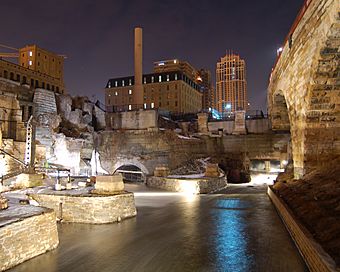Mill Ruins Park facts for kids
Quick facts for kids |
|
|
Mill Ruins Park
|
|
|
U.S. Historic district
Contributing property |
|

This picture shows the output of one of the water power canals that powered mills at Saint Anthony Falls. The west end of the Stone Arch Bridge is directly overhead.
|
|
| Location | Minneapolis, Minnesota |
|---|---|
| Built | Power canal built 1857, mills built between 1859 and the mid-1890s |
| Architect | Minneapolis Mill Company et al. |
| Part of | Saint Anthony Falls Historic District (ID71000438) |
Mill Ruins Park is a cool park in downtown Minneapolis, Minnesota. It sits on the west side of Saint Anthony Falls on the mighty Mississippi River. This park helps us understand the history of flour milling in Minneapolis. You can see the amazing ruins of old flour mills that were left behind.
Contents
Discovering Hidden History
Mill Ruins Park came about because of an important study. This study looked at the history of the Saint Anthony Falls area. This whole area was added to the National Register of Historic Places in 1971. This means it's a very special place worth protecting.
Digging Up the Past
In 1983, people wanted to build a new road along the Mississippi River. Scott Anfinson, an archaeologist, made a plan to check for old historical sites. They dug small test holes along the riverfront. They found many interesting things!
For example, near Bassett's Creek, they found parts of two sawmills. They also found what was left of a roundhouse for trains. Near Hennepin Avenue, they found parts of an old train station. They even found the bases of the first two Hennepin Avenue Bridges.
Uncovering the Mills
In the milling district, archaeologists found clues. These clues showed that a lot of the old mill foundations were still there. The waterpower system that ran the mills was also still hidden underground.
From Digging to Display
At first, the archaeological digs in the 1980s were just to save the ruins. They wanted to protect them from being destroyed by new road projects. But later, in the 1990s, the goal changed.
Making History Visible
The new goal was to show off the ruins for everyone to see. By making the ruins visible, they hoped to create something special. This would be great for learning, for tourists, and for new businesses.
The big digs for Mill Ruins Park started in 1998. They kept digging until 2001. During this time, they also worked to make the Washburn "A" Mill safe. This mill had burned down in 1991. Today, the Washburn "A" Mill is part of the Mill City Museum.
What You Can See at the Park
At Mill Ruins Park, you can explore the remains of several flour mills. You'll also see other old industrial buildings. The park has two stone piers and several iron piers. These used to hold up a train bridge for the Minneapolis Eastern Railroad.
You can also clearly see the tailraces from the waterpower canal. These are channels where water flowed out from the mills. The water flow has even been brought back through the canal! Signs are placed along the walkways. These signs explain the ruins and the history of the area. It's like walking through a giant outdoor museum!
Images for kids
Find Out More
- You can read more about the archaeology of the central Minneapolis riverfront: Part 1 and Part 2.
- Learn about the Saint Anthony Falls Historic District.



